Kanpur
Kanpur (/ˈkɑːnpʊər/ ![]()
Kanpur Cawnpore | |
|---|---|
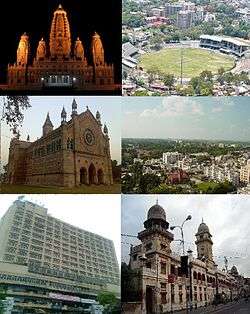 Left to right (from top): JK Temple, Green Park Stadium, Kanpur Memorial Church, Civil Lines, Landmark Hotel, City Kotwali (Police Station) | |
| Nickname(s): | |
 Kanpur The City of Kanpur in the District of Kanpur Nagar | |
| Coordinates: 26.449923°N 80.331874°E | |
| Country | |
| State | Uttar Pradesh |
| Division | Kanpur |
| District | Kanpur Nagar |
| Named for | Raja Kanh Deo |
| Government | |
| • Mayor | Pramila Pandey (BJP) |
| • Divisional Commissioner, Kanpur Division | Sudhir M. Bobde, IAS |
| • District Magistrate, Kanpur Nagar | Dr. Brahmadev Ram Tiwari, IAS |
| • Inspector General of Police, Kanpur Range | Mohit Agarwal, IPS |
| • Senior Superintendent of Police, Kanpur Nagar | Anant Dev Tiwari, IPS |
| Area | |
| • Metropolis | 403.70 km2 (155.87 sq mi) |
| Elevation | 126 m (413 ft) |
| Population | |
| • Metropolis | 2,767,348 |
| • Rank | 12th |
| • Density | 6,900/km2 (18,000/sq mi) |
| • Metro | 2,920,496 |
| • Metro Rank | 11th |
| Demonym(s) | Kanpurite, Kanpuriya |
| Time zone | UTC+05:30 (IST) |
| PIN | 2080XX
('X' will be a natural number ) |
| STD Code | 0512 |
| Vehicle registration | UP 78 YY XXXX ('Y can be a alphanumeric in English and X a natural number) |
| Coastline | 0 kilometres (0 mi) |
| Sex ratio | 855 ♀ / 1000 ♂ |
| Literacy | 84.37% |
| HDI | 0.663[5] |
| Climate | Cwa (Köppen) |
| Website | Official District Website |
The city is famous for its leather and textile industries. It is the 12th most populous city and the 11th most populous urban agglomeration in India. It is also the second largest city proper and the largest urban agglomeration in Uttar Pradesh. Kanpur was an important British garrison town until 1947, when India gained independence. The urban district of Kanpur Nagar serves as the headquarters of the Kanpur Division, Kanpur Range and Kanpur Zone.
On the west bank of the Ganges River, it is a major trade and commercial centre in North India, with the first woolen mill of India, commonly known as the Lal Imli (literally meaning "Red Tamarind", for a brand produced by the mill) by the British India Corporation established here in 1876 by Alexander MacRobert. The eastern and northern facades of the mill are reminiscent of the Palace of Westminster, due to their architecture, proximity to the Ganges river and with the north-east corner of the mill being topped by a clock tower similar to that of the iconic Big Ben in London. This similarity cements the city's importance and prestige during the British times, which extends till date; making the Lal Imli — a great highlight of the city. The city is also widely regarded as the "Leather City of the World" and is predominantly nicknamed as the "Manchester of the East", with some versions going as: the "Manchester of India" — a title shared with other British industrial hubs of their time – cities like Ahmedabad and Surat; mostly for its textile industries.
According to 2011 Indian census, it is the eleventh most populous urban city while the population of city and its suburb were around 5 million making it the eighth-most populous metropolitan area in India. Furthermore, it is considered the world's most polluted city by particulate matter concentration. In 2018, Kanpur, was considered by the World Health Organization as the city with the world's worst air pollution.[6]
History
In 1207, Raja Kanh Deo of the Kanhpuria clan established the village of Kanhpur, which later came to be known as Kanpur.[7][8]
1857 uprising
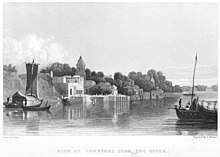
In the 19th century, Cawnpore was an important British garrison with barracks for 7,000 soldiers. During the Indian Rebellion of 1857, 900 British men, women and children were besieged in the fortifications for 22 days by rebels under Nana Sahib Peshwa. They surrendered on the agreement that they would get safe passage to the nearby Satti Chaura Ghat whereupon they would board barges and be allowed to go by river to Allahabad.[9]
Though controversy surrounds what exactly happened at the Satti Chaura Ghat, and who fired the first shot, it is known that, soon afterwards, the departing British were shot at by the rebel sepoys and were either killed or captured. Some of the British officers later claimed that the rebels had, on purpose, placed the boats as high in the mud as possible, to cause delay. They also claimed that Nana Sahib's camp had previously arranged for the rebels to fire upon and kill all the English. Although the East India Company later accused Nana Sahib of betrayal and murder of innocent people, no evidence has ever been found to prove that Nana Sahib had pre-planned or ordered the massacre. Some historians believe that the Satti Chaura Ghat massacre was the result of confusion, and not of any plan implemented by Nana Sahib and his associates. Lieutenant Mowbray Thomson, one of the four male survivors of the massacre, believed that the rank-and-file sepoys who spoke to him did not know of the killing to come.[10]
Many were killed and the remaining 200 British women and children were brought back to shore and sent to a building called the Bibighar (the ladies' home). After some time, the commanders of the rebels decided to kill their hostages. The rebel soldiers refused to carry out orders and butchers from the nearby town were brought in to kill the hostages three days before the British entered the city on 18 July. The dismembered bodies were thrown into a deep well nearby. The British under General Neill retook the city and committed a series of retaliations against the rebel Sepoys and those civilians caught in the area, including women, children and old men. The Cawnpore Massacre, as well as similar events elsewhere, were seen by the British as justification for unrestrained vengeance.[11] "Remember Cawnpore" became a war cry for British for the rest of the rebellion.
Metropolitan area
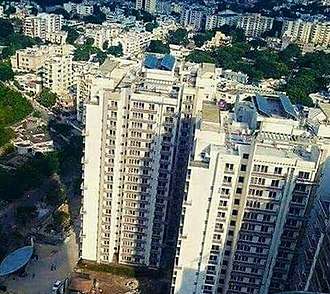
The metropolitan region defined under JNNURM by Kanpur Nagar Nigam, includes the Kanpur Nagar Nigam area, 8 kilometres around KNN boundary and newly included 47 villages of Unnao district on the north-eastern side, it extends to Murtaza Nagar, in the west its limit is up to Akbarpur, Kanpur Dehat Nagar Panchayat limit, on the eastern side the limit has been expanded on the road leading to Fatehpur and in extended up to. The metropolitan region area includes the area of Shuklaganj Municipal Committee (Nagar Palika), Unnao Municipal Committee (Nagar Palika), Akbarpur Village Authority (Nagar Panchayat) and Bithoor Village Authority (Nagar Panchayat) area.[12] In 1997–98, total metropolitan region area has increased to 89131.15 hectare out of which 4,743.9 hectare (5.31%) was non-defined (prohibited area) and rest 29,683 hectare and 54,704 hectare (61.39%) was urban and rural area respectively.
Climate
Kanpur has a dry-winter humid subtropical climate (Cwa) under the Köppen climate classification.
| Climate data for Kanpur Airport (1981–2010, extremes 1901–2006) | |||||||||||||
|---|---|---|---|---|---|---|---|---|---|---|---|---|---|
| Month | Jan | Feb | Mar | Apr | May | Jun | Jul | Aug | Sep | Oct | Nov | Dec | Year |
| Record high °C (°F) | 31.1 (88.0) |
35.6 (96.1) |
42.8 (109.0) |
45.6 (114.1) |
47.2 (117.0) |
47.3 (117.1) |
45.0 (113.0) |
40.6 (105.1) |
40.0 (104.0) |
40.6 (105.1) |
36.1 (97.0) |
31.3 (88.3) |
47.3 (117.1) |
| Average high °C (°F) | 22.3 (72.1) |
25.4 (77.7) |
32.0 (89.6) |
38.0 (100.4) |
39.8 (103.6) |
39.0 (102.2) |
33.8 (92.8) |
33.2 (91.8) |
33.1 (91.6) |
32.5 (90.5) |
28.6 (83.5) |
24.4 (75.9) |
31.9 (89.4) |
| Average low °C (°F) | 8.2 (46.8) |
10.6 (51.1) |
15.6 (60.1) |
21.1 (70.0) |
25.1 (77.2) |
27.2 (81.0) |
26.4 (79.5) |
26.1 (79.0) |
24.8 (76.6) |
19.0 (66.2) |
12.8 (55.0) |
8.7 (47.7) |
18.8 (65.8) |
| Record low °C (°F) | 1.6 (34.9) |
0.6 (33.1) |
7.2 (45.0) |
11.1 (52.0) |
16.4 (61.5) |
20.6 (69.1) |
21.7 (71.1) |
21.7 (71.1) |
11.8 (53.2) |
4.6 (40.3) |
0.5 (32.9) |
−0.9 (30.4) |
−0.9 (30.4) |
| Average rainfall mm (inches) | 9.2 (0.36) |
9.2 (0.36) |
2.9 (0.11) |
2.7 (0.11) |
8.2 (0.32) |
61.8 (2.43) |
185.3 (7.30) |
191.7 (7.55) |
138.1 (5.44) |
33.9 (1.33) |
3.4 (0.13) |
2.1 (0.08) |
648.5 (25.53) |
| Average rainy days | 0.8 | 0.8 | 0.4 | 0.3 | 0.8 | 2.9 | 9.6 | 9.0 | 6.1 | 1.4 | 0.3 | 0.2 | 32.7 |
| Average relative humidity (%) (at 17:30 IST) | 59 | 46 | 34 | 27 | 31 | 45 | 74 | 77 | 72 | 62 | 62 | 62 | 54 |
| Source: India Meteorological Department[13][14] | |||||||||||||
Demographics
As per the provisional results of 2011 census, Kanpur city has a population of 2,767,031.[16] The literacy rate was 84.14 per cent and sex ratio was 842.[16] The Kanpur urban agglomeration had a population of 2,920,067 with a literacy rate of 83.98% and a sex ratio of 842.[17]
There are 35 Parsis in Kanpur with their Fire Temple at The Mall.[18]
Hinduism is a majority in Kanpur with sizeable minority of Muslims. Sikhs, Christians and Buddhists are below 2 percent.
Administration and Politics
| Officials | |
| Divisional Commissioner | |
| District Magistrate | |
| Additional Director General, Kanpur Zone | Avanish Chandra[22] |
| Inspector General, Kanpur Range | Alok Singh[23] |
| DIG/Senior Superintendent of Police | Sonia Singh[24] |
| Vice Chairman, Kanpur Development Authority | Kinjal Singh[25][26] |
| Mayor | |
| Municipal Commissioner | Avinash Singh[27][28][29] |
| District Judge | Shashi Kant Shukla[30] |
| Chief Metropolitan Magistrate | Shabistan Aquil[30] |
Administration
General administration
Kanpur division which consists of seven districts, and is headed by the divisional commissioner of Kanpur, who is an Indian Administrative Service (IAS) officer of high seniority, the commissioner is the head of local government institutions (including municipal corporations) in the division, is in charge of infrastructure development in his division, and is also responsible for maintaining law and order in the division.[31][32][33][34] The district magistrate of Kanpur reports to the divisional commissioner. The current commissioner is Pradeep Kumar Mohanty.[19][20][21]
Kanpur district administration is headed by the district magistrate of Kanpur, who is an IAS officer. The DM is in charge of property records and revenue collection for the central government and oversees the elections held in the city. The DM is also responsible for maintaining law and order in the city.[31][35][36][37] The DM is assisted by a chief development officer; four additional district magistrates for finance/revenue, city, land acquisition, and civil supply; one city magistrat; and seven additional city magistrates.[38] The district has three tehsils viz. Sadar, Bilhaur and Ghatampur, each headed by a sub-divisional magistrate.[38] The current DM is Vijay Vishwas Pant.[19][20][21]
Police administration
Kanpur district comes under the Kanpur Police Zone and Kanpur Police Range, Kanpur Zone is headed by an additional director general-ranked Indian Police Service (IPS) officer, and the Kanpur Range is headed inspector general-ranked IPS officer. The current ADG, Kanpur Zone is Avanish Chandra,[22] and IG, Kanpur Range is Alok Singh.[23]
The district police is headed by a deputy inspector general/senior superintendent of police (DIG/SSP), who is an IPS officer, and is assisted by seven superintendents of police or additional superintendents of police for east, west, south, rural area, crime, traffic and modern control, who are either IPS officers or Provincial Police Service (PPS) officers.[24] Each of the several police circles is headed by a circle officer (CO) in the rank of deputy superintendent of police.[24] The current DIG/SSP is Sonia Singh.[24]
Civic Administration
The development of infrastructure in the city is overseen by Kanpur Development Authority (KDA), which comes under the Housing Department of Uttar Pradesh government. The divisional commissioner of Kanpur acts as the ex-officio Chairman of KDA, whereas a vice chairperson, a government-appointed IAS officer, looks after the daily matters of the authority.[39] The current vice-chairman of Kanpur Development Authority is K. Vijayendra Pandian.[25][26]
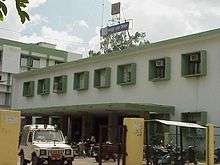
The Kanpur Municipal Corporations oversees civic activities in the city, the head of the corporation is the mayor, but the executive and administration of the corporation are the responsibility of the municipal commissioner, who is an Uttar Pradesh government-appointed Provincial Civil Service officer of high seniority. The current mayor of Kanpur is Captain (retired) Jagat Vir Singh Drona,[27] whereas the municipal commissioner is Avinash Singh.[27][28][29]
Judiciary
The Kanpur District Court is headed by the district judge of Kanpur, who is assisted by numerous additional district judges, civil judges (senior division) and additional civil judges. Kanpur is a notified metropolitan area by UP Government under Code of Criminal Procedure, 1973, and therefore has a chief metropolitan magistrate, who is assisted by several metropolitan magistrates. The current district judge is Shashi Kant Shukla,[30] and the current chief metropolitan magistrate is Shabistan Aquil.[30]
Politics
Kanpur Nagar district encompasses one Lok Sabha constituency and ten Uttar Pradesh Vidhan Sabha constituencies. The current member of parliament in Lok Sabha for Kanpur is Satyadev Pachauri.
Transport
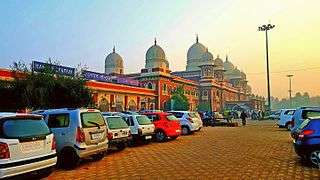
Airways
Ganesh Shankar Vidyarthi Airport has scheduled commercial flights to Delhi, Mumbai, Kolkata, Bangalore and other cities of India. The nearest International Airport is the Chaudhary Charan Singh International Airport in Lucknow, which is around 77.1 km from Kanpur.
Railways
Kanpur Central is a major railhead and is among the busiest railway stations in the country. Rail routes connect it to all major cities in the state and the country. It is an A-1 category railway station coming under the Allahabad railway division of North Central Railway zone of Indian Railways. Around 300 trains pass through the station daily.[40] Other major railway stations serving the city include Kanpur Anwarganj, Govindpuri, Panki, Kalianpur, Rawatpur, Chandari, Kanpur Bridge and Chakeri.
Roadways
The city has had chronic problems with maintaining local roads.[41] There are several important National Highways that pass through Kanpur.
| NH No | Route | Total Length |
|---|---|---|
| NH 2 | Delhi » Mathura » Agra » Kanpur » Allahabad » Varanasi » Mohania » Barhi » Palsit » Dankuni (near Kolkata) | 2542 |
| NH 25 | Lucknow » Kanpur » Jhansi | 352 |
| NH 86 | Kanpur » Hamirpur » Mahoba » Chhatarpur » Sagar » Bhopal » Indore | 674 |
| NH 91 | Ghaziabad » Aligarh » Etah » Kannauj » Kanpur | 405 |
| NH 157 (Proposed) | Kanpur » Raebareli » Sultanpur » Shahganj » Azamgarh » Gaura Barhaj » Siwan » Muzaffarpur | 581 |
The UPSRTC Inter State Bus Station (ISBT) of Kanpur officially named as the "Shaheed Major Salman Khan Bus Station". It is locally known as the "Jhakarkati Bus Station". It provides buses to important cities of India.[42] Other UPSRTC controlled Important Bus stations are Chunniganj Bus Stand for Farrukhabad, Bareilly and Uttranchal routes, Naubasta Bus Stand for Hamirpur route, Fazalganj is another hub for Private carriers.
Ring road
In 2011 it was reported by The Indian Express that "The National Highways Authority of India (NHAI) is all set to develop a four-lane outer ring road along the periphery of Kanpur with an aim to prevent traffic congestion in the industrial city caused by long-distance heavy vehicles. The new road, which will help the heavy vehicles to bypass the city, will be developed on Built, Operate and Transfer (BOT) basis under the phase-VII of National Highways Development Programme (NHDP)"[43]
Kanpur Metro
Kanpur Metro is an under construction rail based mass transit system in the city of Kanpur, India which shall further be extendable to Kanpur metropolitan area. The work of the first metro depot is 70 percent complete.[44] [45]
Education and research
Higher education
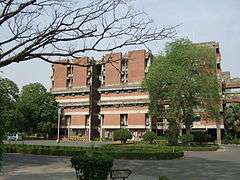
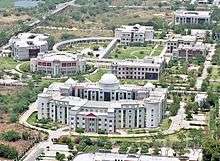
Educational institutions in the city include three state universities. Chhatrapati Shahu Ji Maharaj University is one of the largest universities in Asia catering to urban and rural students offering professional and academic courses in disciplines of Arts, Science, Commerce, Law, Engineering, Biotechnology, Computer Applications, Management and Medicine. Chandra Shekhar Azad University of Agriculture and Technology is an agricultural university named after the Indian revolutionary Chandrashekhar Azad which caters to the needs of the farming community of 29 districts of Uttar Pradesh. Harcourt Butler Technical University (HBTI) offers Bachelors, Masters, and Doctoral programs in engineering, as well as Masters programs in Business Administration, and Computer Applications. A public engineering institution Indian Institute of Technology Kanpur is in the city. It was one of the first Indian Institutes of Technology established in 1959, created with the assistance of a consortium of nine US research universities as part of the Kanpur Indo-American Programme (KIAP).[46][47] There is also a private university in the city: Rama University part of the Rama Group.[48] There are several private Technical and Management institutions.
Medical education
Ganesh Shankar Vidyarthi Memorial Medical College (GSVM Medical College) is a state-run medical college in Kanpur, Uttar Pradesh. It was founded in 1956 and named after Ganesh Shankar Vidyarthi, a freedom fighter and journalist from Kanpur. Lala Lajpat Rai Hospital, which is also known as Hallet Hospital, is associated with GSVM, Kanpur.
See also
- Kanpur Dehat (Lok Sabha constituency)
- Ethnic communities in Kanpur
- List of cities in Uttar Pradesh
- List of engineering colleges in Kanpur
- Renamed places in Kanpur
- List of twin towns and sister cities in India
- Second Battle of Cawnpore
References
- "Kanpur India - Kanpur Uttar Pradesh, Kanpur City, Kanpur Guide, Kanpur Location". Iloveindia.com. Archived from the original on 22 November 2012. Retrieved 19 December 2012.
- "Nick Name of Indian Places". Facts-about-india.com. Archived from the original on 21 February 2012. Retrieved 19 December 2012.
- "Uttar Pradesh (India): Districts, Cities, Towns and Outgrowth Wards - Population Statistics in Maps and Charts". City population.de. Archived from the original on 31 May 2016. Retrieved 7 June 2016.
- "Uttar Pradesh (India): State, Major Agglomerations & Cities - Population Statistics in Maps and Charts". City population.de. Archived from the original on 29 June 2016. Retrieved 9 July 2016.
- "Archived copy" (PDF). Archived (PDF) from the original on 19 June 2018. Retrieved 8 March 2019.CS1 maint: archived copy as title (link)
- Dasgupta, Neha (16 May 2018). "With world's worst air, Indian city struggles to track pollution". Yahoo News. United States. Reuters. Archived from the original on 16 May 2018. Retrieved 16 May 2018.
"Indian city struggles with 'world's worst air'". Washington Post. United States. 16 May 2018. Archived from the original on 4 July 2018. Retrieved 16 May 2018. - "Kanpur History - History of Kanpur City- History of Kanpur India". Journeymart.com. Archived from the original on 2 July 2015. Retrieved 29 July 2015.
- "Man" (PDF). Dspace.wbpublisher.gov.in. p. 479. Archived (PDF) from the original on 2 July 2015. Retrieved 29 July 2015.
- Wright, Caleb (1863) [1863]. Historic Incidents and Life in India. J. A. Brainerd. p. 239. ISBN 978-1-135-72312-5.
- Sen, Surendra Nath (1995) [1957]. Eighteen Fifty-seven. Publications Division, Ministry of Information & Broadcasting, Government of India. p. 145. ISBN 978-81-230-0093-0.
- Dalrymple, W. 2007. The Last Mughal. The Fall of a Dynasty: Delhi, 1857, Alfred Knopf, New York
- "Final Report : Kanpur City" (PDF). Jnnurm.nic.in. Archived from the original (PDF) on 18 February 2015. Retrieved 29 July 2015.
- "Station: Kanpur (A) Climatological Table 1981–2010" (PDF). Climatological Normals 1981–2010. India Meteorological Department. January 2015. pp. 387–388. Archived from the original (PDF) on 5 February 2020. Retrieved 27 April 2020.
- "Extremes of Temperature & Rainfall for Indian Stations (Up to 2012)" (PDF). India Meteorological Department. December 2016. p. M217. Archived from the original (PDF) on 5 February 2020. Retrieved 27 April 2020.
- "Kanpur City Census 2011 data". Census 2011 India. Archived from the original on 5 May 2017. Retrieved 8 April 2017.
- "Provisional Population Totals, Census of India 2011; Cities having population 1 lakh and above" (PDF). Office of the Registrar General & Census Commissioner, India. Archived from the original (PDF) on 7 May 2012. Retrieved 26 March 2012.
- "Urban agglomerations/cities having population 1 million and above" (PDF). Provisional population totals, census of India 2011. Registrar General & Census Commissioner, India. 2011. Archived (PDF) from the original on 15 December 2011. Retrieved 26 January 2012.
- "Appeal – Cawnpore Parsee Anjuman, Kanpur | Parsis, Iranis, Zarathushtis - ALL Under One Roof". Zoroastrians.net. Archived from the original on 20 May 2014. Retrieved 29 July 2015.
- "Contact Details Of Commissioners and District Magistrates Of U.P." Department of Home and Confidential, Government of Uttar Pradesh. Archived from the original on 16 August 2017. Retrieved 15 August 2017.
- जिलाधिकारी/मंडलायुक्त की सूची [List of District Magistrates and Divisional Commissioners]. Department of Appointments and Personnel, Government of Uttar Pradesh (in Hindi). Archived from the original on 10 February 2011. Retrieved 15 August 2017.
- "Administrative Officers of Kanpur Nagar". Kanpur Nagar District website. Archived from the original on 15 August 2017. Retrieved 16 August 2017.
- "Officers posted at Kanpur Zone". Uttar Pradesh Police. Archived from the original on 17 August 2017. Retrieved 16 August 2017.
- "Officers posted at Kanpur Range". Uttar Pradesh Police. Archived from the original on 17 August 2017. Retrieved 16 August 2017.
- "Officers posted at KANPUR NAGAR". Uttar Pradesh Police. Archived from the original on 17 August 2017. Retrieved 16 August 2017.
- "Contact Us". Kanpur Development Authority. Archived from the original on 17 August 2017. Retrieved 16 August 2017.
- "List of IAS officers who are Vice Chairmen of Development Authorities". Department of Appointment and Personnel, Government of Uttar Pradesh. Archived from the original on 21 August 2017. Retrieved 21 August 2017.
- "Home Page". Kanpur Municipal Corporation. Archived from the original on 13 April 2012. Retrieved 16 August 2017.
- वरिष्ठ अधिकारी [Senior Officers]. Kanpur Municipal Corporation (in Hindi). Archived from the original on 17 August 2017. Retrieved 16 August 2017.
- "PCS OFFICERS (Posted as HOD)". Department of Appointment and Personnel, Government of Uttar Pradesh. Archived from the original on 11 February 2011. Retrieved 21 August 2017.
- "Judicial Officers in Kanpur Nagar". Allahabad High Court. Archived from the original on 17 August 2017. Retrieved 16 August 2017.
- "CONSTITUTIONAL SETUP". Government of Uttar Pradesh. Archived from the original on 31 August 2017. Retrieved 30 August 2017.
- Maheshwari, S.R. (2000). Indian Administration (6th Edition). New Delhi: Orient Blackswan Private Ltd. pp. 563–572. ISBN 9788125019886.
- Singh, G.P. (1993). Revenue administration in India: A case study of Bihar. Delhi: Mittal Publications. pp. 26–129. ISBN 978-8170993810.
- Laxmikanth, M. (2014). Governance in India (2nd Edition). Noida: McGraw Hill Education. pp. 5.1–5.2. ISBN 978-9339204785.
- Maheshwari, S.R. (2000). Indian Administration (6th Edition). New Delhi: Orient Blackswan Private Ltd. pp. 573–597. ISBN 9788125019886.
- Laxmikanth, M. (2014). Governance in India (2nd Edition). Noida: McGraw Hill Education. pp. 6.1–6.6. ISBN 978-9339204785.
- Singh, G.P. (1993). Revenue administration in India: A case study of Bihar. Delhi: Mittal Publications. pp. 50–124. ISBN 978-8170993810.
- "Work Distribution :-". Kanpur Nagar district website. Archived from the original on 13 February 2018. Retrieved 16 August 2017.
- "About KDA". Kanpur Development Authority. Archived from the original on 9 August 2017. Retrieved 16 August 2017.
- TN (7 November 2010). "Around 300 trains pass through Kanpur Central daily". The Times of India. Archived from the original on 17 June 2018. Retrieved 15 April 2018.
- Potholed roads, eight to ten hours long power cut, overflowing drains and contaminated drinking water which lead to bad health and contagious diseases tell the tale of the Industrial town, which is fast turning into a big slum. Siddiqui, Faiz Rahman (29 April 2014). "'Outsider' Joshi takes on 'local' Jaiswal". The Times of India. Archived from the original on 21 July 2014.
- "UPSRTC". UPSRTC. Archived from the original on 28 January 2013. Retrieved 19 December 2012.
- "Kanpur to get outer ring road to bypass traffic blues". Indianepress.com. Archived from the original on 3 March 2011. Retrieved 20 January 2011.
- https://wap.business-standard.com/article/news-cm/cabinet-approves-kanpur-metro-rail-project-119030100274_1.html
- <https://m.patrika.com/kanpur-news/kanpur-metro-rail-corporation-kmrc-first-phase-construction-from-iit-to-benajhawar-1629207/ Archived 5 March 2019 at the Wayback Machine
- Norman Dahl: Kanpur Indo-American Program; http://csg.csail.mit.edu/Dahl/kiapbooklet.pdf Archived 12 August 2011 at the Wayback Machine
- Financial Statements and Performance Indicators. Jump up ^ Kelkar, P.K. (17 March 2006). "IIT Kanpur — History". IIT Kanpur
- Private University Uttar Pradesh; http://www.ugc.ac.in/privateuniversitylist.aspx?id=33&Unitype=3 Archived 7 September 2017 at the Wayback Machine
External links
| Wikimedia Commons has media related to Kanpur. |
| Wikisource has the text of the 1911 Encyclopædia Britannica article Cawnpore. |
| Wikivoyage has a travel guide for Kanpur. |